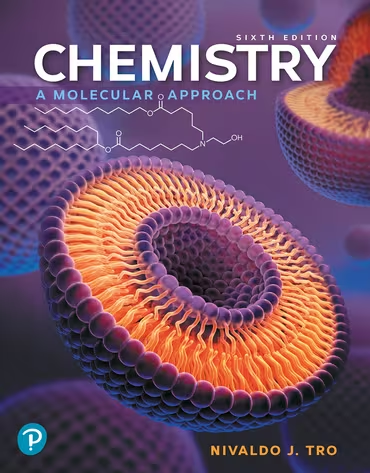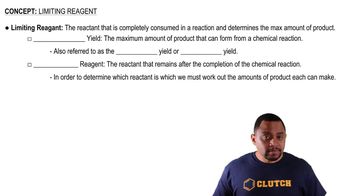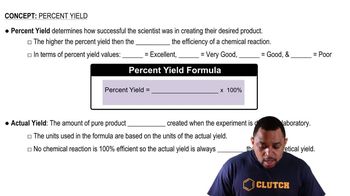Iron(III) oxide reacts with carbon monoxide according to the equation: Fe2O3(s) + 3 CO(g) → 2 Fe(s) + 3 CO2(g) A reaction mixture initially contains 45.10 g Fe2O3 and 29.56 g CO. Once the reaction has occurred as completely as possible, what mass (in g) of the excess reactant remains?

Urea (CH4N2O) is a common fertilizer that is synthesized by the reaction of ammonia (NH3) with carbon dioxide: 2 NH3(aq) + CO2(aq) → CH4N2O(aq) + H2O(l) In an industrial synthesis of urea, a chemist combines 149.4 kg of ammonia with 231.1 kg of carbon dioxide and obtains 172.3 kg of urea. Determine the limiting reactant, theoretical yield of urea, and percent yield for the reaction.
 Verified step by step guidance
Verified step by step guidance
Verified video answer for a similar problem:
Key Concepts
Limiting Reactant

Theoretical Yield

Percent Yield

Elemental phosphorus reacts with chlorine gas according to the equation: P4(s) + 6 Cl2( g) → 4 PCl3(l) A reaction mixture initially contains 91.38 g P4 and 262.6 g Cl2. Once the reaction has occurred as completely as possible, what mass (in g) of the excess reactant remains?
Magnesium oxide can be made by heating magnesium metal in the presence of oxygen. The balanced equation for the reaction is: 2 Mg(s) + O2(g) → 2 MgO(s) When 13.1 g of Mg reacts with 13.6 g O2, 12.4 g MgO is collected. Determine the limiting reactant, theoretical yield, and percent yield for the reaction.
Many computer chips are manufactured from silicon, which occurs in nature as SiO2. When SiO2 is heated to melting, it reacts with solid carbon to form liquid silicon and carbon monoxide gas. In an industrial preparation of silicon, 177.4 kg of SiO2 reacts with 100.1 kg of carbon to produce 71.2 kg of silicon. Determine the percent yield for the reaction.
Write the balanced chemical equation for the reaction of solid strontium with iodine gas.
